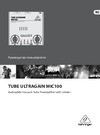M-Audio Flying Cow [8/20] Installation and typical setup
![M-Audio Flying Cow [8/20] Installation and typical setup](/views2/1790288/page8/bg8.png)
8
Installation and Typical Setup
Your Flying Cow box should contain this manual, a “wallwart”
power transformer (U.S. customers only) and the Flying Cow
unit itself. Please save all packing materials in case you should
ever need to ship the unit.
The Flying Cow may be operated on any flat surface or it may be
installed in a standard 19” rack equipment tray. For installation
in a 19” rack tray you will first need to remove the four rubber
feet from the unit. Next, left or right justify the Flying Cow in
the rack tray. Lastly, tighten the included rack-mount screw,
through the rack tray hole, into the single threaded hole on the
bottom of the Flying Cow chassis.
Plug in the power supply. With the Flying Cow’s power turned
off, make your connections to any analog or digital cables you
will be using. Next, power up the Flying Cow by pressing the
Power button on the front panel.
IMPORTANT: Before powering up the Flying Cow, turn down
any amplifiers (or mixers) connected to the Flying Cow’s outputs.
Since it takes several milliseconds for the Flying Cow to acquire
and lock onto an incoming digital signal, there may be a slight
“pop” sound while powering up.
A typical configuration in which a Flying Cow would be used
includes a Flying Cow, a PC based digital I/O card, a mixer and
an amplifier/sound system (see Typical Setup figure). Such a
configuration could be setup as follows: 1.) the unbalanced stereo
audio out of the mixer goes to the 1/4” audio inputs on the
Flying Cow, 2.) the S/PDIF out of the digital audio card goes to
the S/PDIF In on the Flying Cow, 3.) the S/PDIF in of the digital
audio card goes to the S/PDIF Out on the Flying Cow, 4.) the
unbalanced Analog Out on the Flying Cow goes to a line level
audio in on the amplifier/sound system.
Содержание
- Table of contents p.1
- Note connecting this device to peripheral devices that do not comply with class b requirements or using an unshielded peripheral data cable could also result in harmful interference to radio or television reception p.2
- Fcc class b and ce compliance p.2
- Overview p.3
- Features p.4
- Panels fig 1 p.5
- Flying cow p.5
- Panel description p.6
- Installation and typical setup p.8
- Typical setup fig 2 p.9
- Flying cow p.9
- Channel mixer p.9
- Operation p.10
- Troubleshooting p.14
- Appendix a specifications p.16
- Appendix b diagnostic tests p.17
- Converter p.18
- Appendix c block diagram p.18
- A d sample rate p.18
- A d converter p.18
- Right analog output p.18
- Right analog input p.18
- Left analog output p.18
- Left analog input p.18
- Incoming signals with no discernible distortion p.18
- Digital outputs p.18
- Digital inputs p.18
- Digital format p.18
- D a converter p.18
- Appendix d grounding p.19
- Lifetime limited warranty p.20
Похожие устройства
-
 M-Audio Flying CalfИнструкция по использованию
M-Audio Flying CalfИнструкция по использованию -
 M-Audio Flying CalfРуководство по эксплуатации
M-Audio Flying CalfРуководство по эксплуатации -
 M-Audio Flying CalfКраткое руководство
M-Audio Flying CalfКраткое руководство -
 M-Audio Flying CowИнструкция по использованию
M-Audio Flying CowИнструкция по использованию -
 M-Audio Flying CowКраткое руководство
M-Audio Flying CowКраткое руководство -
 M-Audio TAMPAРуководство по эксплуатации
M-Audio TAMPAРуководство по эксплуатации -
 M-Audio TAMPAКраткое руководство
M-Audio TAMPAКраткое руководство -
 M-Audio Audio BuddyИнструкция по эксплуатации
M-Audio Audio BuddyИнструкция по эксплуатации -
 M-Audio CO2Инструкция по эксплуатации
M-Audio CO2Инструкция по эксплуатации -
 M-Audio DMP2Инструкция по эксплуатации
M-Audio DMP2Инструкция по эксплуатации -
 M-Audio OctaneИнструкция по эксплуатации
M-Audio OctaneИнструкция по эксплуатации -
 Behringer TUBE ULTRAGAIN MIC100Руководство по эксплуатации
Behringer TUBE ULTRAGAIN MIC100Руководство по эксплуатации
![M-Audio Flying Cow [8/20] Installation and typical setup](/img/pdf.png)